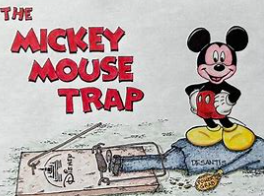On January 1st, when Disney’s copyright on the earliest versions of Mickey Mouse expired, a trailer for a horror film and a new horror game featuring Mickey Mouse was released. The film, “Mickey’s Mouse Trap”, and the game, “Infestation 88”, both take a dark twist on the character from the 1928 short film “Steamboat Willie”. This follows a trend of childhood characters being used in horror contexts, like Winnie the Pooh in “Blood and Honey”. Despite the public domain status of early Mickey Mouse, Disney maintains copyright over more modern versions and continues to protect its brand.

Mickey Mouse as a character

Mickey Mouse, a cherished cartoon character, was created by Walt Disney and Ub Iwerks in 1928. As Disney’s mascot, Mickey is an endearing anthropomorphic mouse. He’s known for his resourcefulness and resilience in overcoming challenges. Mickey debuted in “Steamboat Willie”. His universe comprises his girlfriend Minnie Mouse, his pet Pluto, friends Donald Duck and Goofy, and his adversary Pete. Mickey is one of the most universally acclaimed fictional characters.
Interestingly, the earliest version of Mickey is now in the public domain and will be featured in two forthcoming horror films, demonstrating his enduring appeal and versatility.
Infestation 88: Mickey Mouse horror game

The horror game “Infestation 88”, inspired by Mickey Mouse, faced controversy due to perceived Neo-Nazi references and Holocaust imagery. Responding to the backlash, developers Nightmare Forge Games clarified that ‘88’ represented the year 1988, not any Neo-Nazi symbolism, and changed the game’s title to “Infestation: Origins”. The game, set in 1988, involves players dealing with infestations caused by distorted versions of classic characters. The freedom to use characters from “Steamboat Willie”, now in the public domain, has led to controversial reinterpretations, potentially making them a ‘political lightning rod in pop culture’.
Disney has a long history of strict enforcement of its copyright laws, which has sometimes led to conflicts with artists like cartoonist Dan O’Neill. This incident with “Infestation 88” highlights the complexities and potential pitfalls of copyright law in the entertainment industry.
A Darker Side of Mickey Mouse

Mickey Mouse, a character beloved by many, has recently been reimagined in a more menacing light through fan art and parodies. These creative reinterpretations, which portray Mickey with sharp teeth, glowing eyes, and a wicked smile, have caught the attention of filmmakers and producers in the horror genre.
Soon, this darker version of Mickey made its debut in a series of short films and spin-offs, transforming familiar settings from Mickey’s world into eerie, suspense-filled landscapes. This unexpected portrayal of Mickey left audiences both startled and intrigued.

Interestingly, this isn’t the first instance of a character entering the public domain being used in such a manner. Winnie the Pooh, who entered the public domain in 2022, was featured in a low-budget horror film titled “Winnie the Pooh: Blood and Honey”.
It’s worth noting that only the original versions of Mickey and Minnie Mouse are in the public domain, not the modern designs. Disney has made it clear that they will continue to protect their rights in these modern versions.
Steven LaMorte, the director of an upcoming film featuring the character from “Steamboat Willie”, has assured that his team is working with legal experts to avoid infringing on Disney’s rights. They plan to refer to their character as Steamboat Willie, not Mickey Mouse, to avoid any confusion. The release dates for the films are yet to be announced.
A New Era of Horror

Mickey Mouse’s transformation into a horror icon has significantly impacted popular culture, leading to debates about storytelling boundaries and the power of reimagining familiar characters. While some fans have welcomed this new version of Mickey, others are concerned about its potential impact on younger audiences. Despite this, Mickey’s venture into horror has inspired filmmakers and storytellers to explore unconventional narratives and challenge genre norms. This has reignited interest in the character and sparked a wave of innovative storytelling that merges childhood nostalgia with adult terror.
Mickey Mouse’s evolution from a friendly cartoon character to a horror movie star demonstrates the enduring power of storytelling and the limitless potential for reinvention. This transformation may unsettle some fans, but it has undoubtedly ushered in a new era of creativity and imagination in the entertainment world.












Comments 1